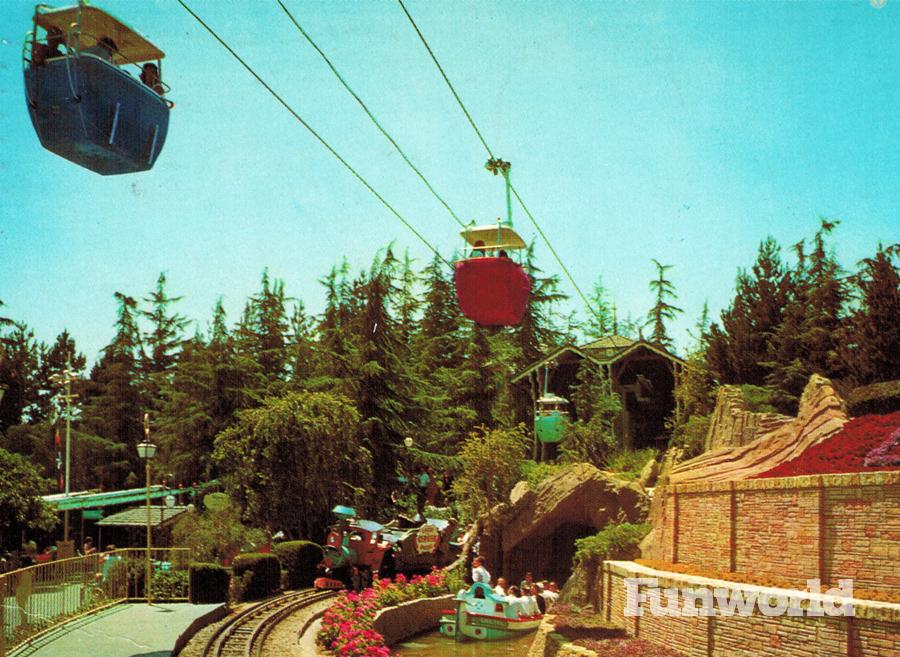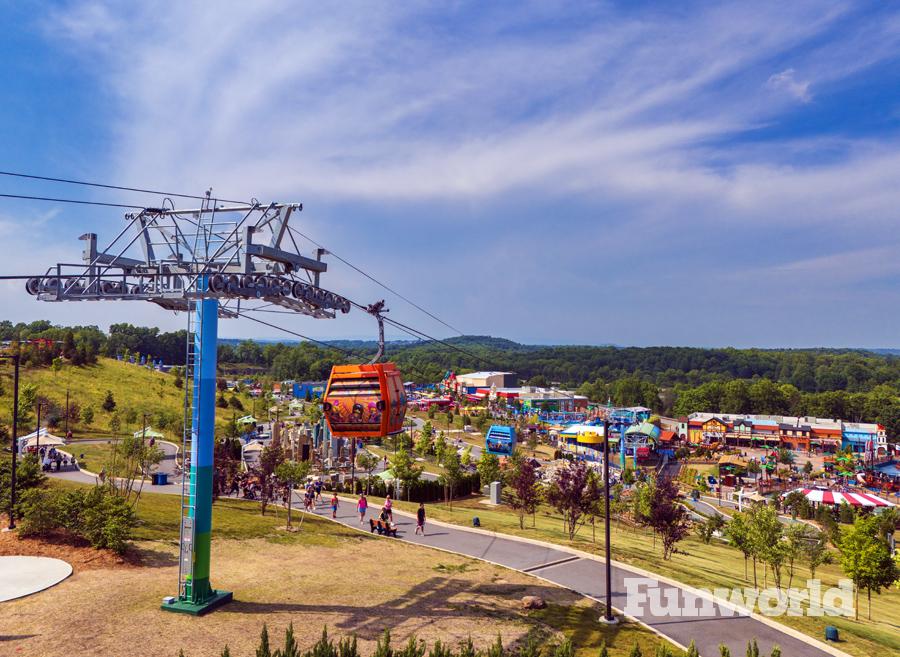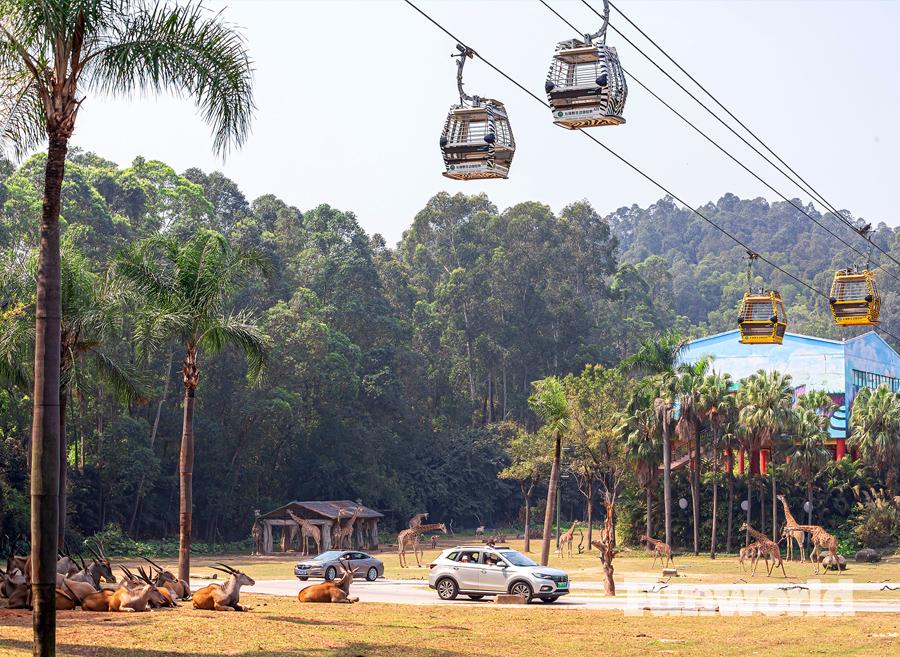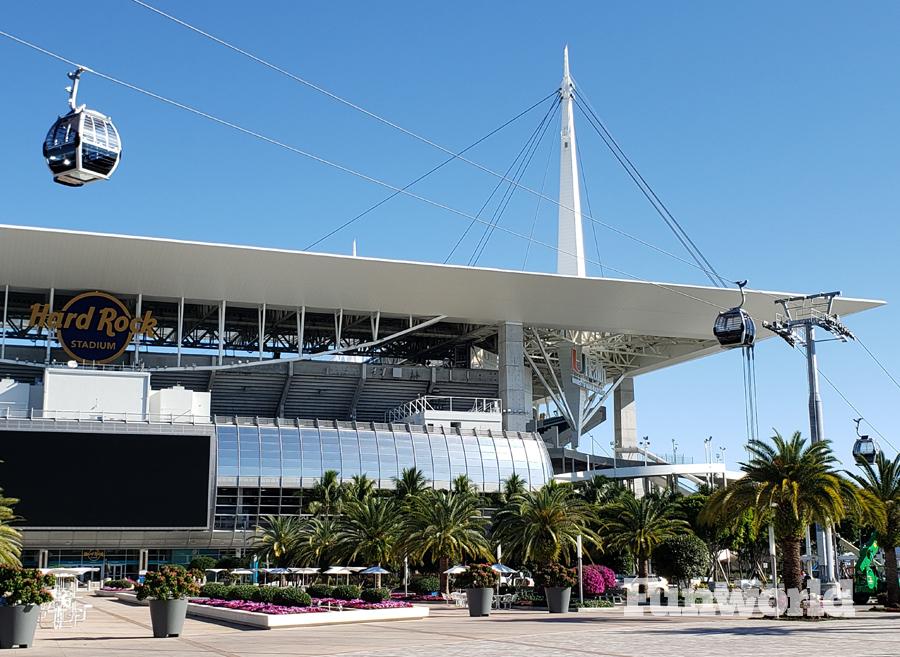In the decades following World War II, the rise of theme parks transformed the attractions industry, eschewing traditional thrill rides in favor of family-oriented attractions such as trains, themed boat rides, log flumes, runaway mine trains, and cable cars.
First introduced at Disneyland in 1956, the installation of cable car rides became a trend that quickly took hold. They served as landmarks, transportation systems, and a way for families to soar above the park and absorb the scenic landscape. Soon, they were a standard feature at most theme parks, including Cedar Point and Marriott’s Great America (now known as Six Flags Great Adventure) in Gurnee, Illinois, which added a second cable car ride.
Most larger parks relied on the Swiss company Von Roll to build their cable cars, and by the 1960s, manufacturers such as Universal Design and OD Hopkins began making systems for smaller attractions.
More than 100 Von Roll cable cars and dozens of smaller cable car rides opened throughout the world during this time, but by the late 1980s, they started to disappear as changing tastes and maintenance challenges necessitated their removal. Von Roll exited the business in 1996, selling their aerial tramway and cableway division to Doppelmayr of Wolfurt, Austria. Today, only a handful of the original Von Roll cable car rides remain in operation.
An Unexpected Resurgence
In recent years, cable cars have made a comeback. Theme parks and zoos are taking a renewed interest in their installation, but as the scope of the attractions industry has broadened, so has the use of cable car attractions.
While a handful of theme parks have replaced cable cars with newer models in recent years, in 2024, Legoland New York Resort in Goshen opened the Minifigure Skyflyer. Supplied by Leitner-Poma, the North American division of HTI Group of Italy, it is one of the first all-new cable car rides installed at a theme park in many years.
Lauren Truskowski, senior communications manager, says the installation was a result of guest feedback requesting easier ways to navigate the hilly park, which can be strenuous for certain guest demographics. “The attraction allows for an easy way to get from the top of the park to the bottom—and has the benefit of being able to get a fantastic view of our seven Lego themed lands.”
Eastern General Manager for Leitner-Poma, Michael Manley, agrees. “The layout of the park lends itself to the gondola solution as a means to spread out guests as they enter the park, and to expedite guests’ exit at the end of the day. Visitors are treated to an immersive, interactive experience that is unique for a sky ride. “The attraction itself has a Disco Dance Floor in the line, where visitors are taught dance moves to help ‘power the Skyflyer.’ Then, each of the Party Pods has its own theme—from Pirates to Food to Galaxy,” says Truskowski. Furthermore, the seven “Party Pods” have their own interactive in-flight activities.
Zoos and safari parks also recognize the advantages of adding cable car attractions, particularly given their small footprint and energy efficient operation. In 2017, the Oakland Zoo opened the California Trail, a 56-acre expansion separated from the main zoo by a protected ecosystem. The Gondola, a cable car ride from Doppelmayr, provided the zoo with a low impact way to link the two sites while allowing guests to preview animal habitats and enjoy the view of San Francisco Bay.
While the Oakland Zoo saw a cable car installation as way to expand their attraction, Kolmården Wildlife Park in Sweden saw an opportunity in 2011 to enhance their facility and solve a major operational challenge when it came time to replace their 1967 vintage cable car.
According to Peter Osbeck, senior ride manager for Kolmården’s owner, Parks and Resorts Scandinavia, their drive through animal safari presented a series of problems—including traffic congestion, environmental concerns, and safety issues. “When you drive around with lions and bears, things happen,” says Osbeck. A new cable car system appealed to Kolmården as a more effective way to view the animals and the adjacent Baltic Sea while reinforcing the park’s environmental mission.
According to Shawn Marquardt, vice president of sales for Doppelmayr USA, the environmentally friendly nature of cable car rides is a key selling point, citing the low impact on the landscape and emission-free propulsion system. Osbeck adds that the quiet operation of cable cars is also healthier for the animals than passing automobiles.
Unlike the original cable car, which was primarily a point-to-point transportation ride, the 2.6-kilometer Doppelmayr system travels in a unique circular path that crosses itself several times, providing a greater level of interactivity with the animals. Named Safaribanan, the ride ranks among the three most popular attractions at the wildlife park—with two-thirds of their 660,000 guests enjoying the ride in 2023.
Cable cars at zoos and safari parks are relatively new in Asia. Chimelong Safari Park in Guangzhou, China, opened a cable car attraction in 2017.
Chimelong Safari Park first opened in 1997 as a walk-through experience, which was complemented by a separate ride-through safari in 2004. According to Chimelong Group, the company decided to enhance the existing experiences with the cable car ride to increase the number of experiences and grow revenue.
The 2.4-kilometer system from POMA, based in Voreppe, France, has a triangular layout featuring three independent, connected systems. Each line has its own identity and allows guests to view both the walk-through and drive-through sections from the air. One-third of the 224 animal-themed gondolas feature clear glass floors, permitting a 720-degree aerial view of the animals below. According to Chimelong, safari park attendance increased roughly 25% following the opening of the cable car.
A Growing Number of Applications
For Doppelmayr, capitalizing on the potential of installations in a more diverse range of attractions was part of a deliberate strategy. “Winter and mountain uses will always be our core business,” said Marquardt. “But they reached a plateau,” explaining that urban transportation and “points of interest”—or cable cars installed to provide a better viewpoint of landmark attractions—were natural extensions. Over the past five years, Doppelmayr has seen point of interest installations comprise 20% of its sales.
Scenic attractions are an emerging genre around the world and cable cars have become standard features in many of them. The United States’ Great Smoky Mountains region has one of the heaviest concentrations, with four separate cable car attractions. Two established systems have recently replaced their older systems, while two others—Anakeesta and Skyland Ranch—opened cable cars in 2017.
“Anakeesta is all about being outdoors in the Great Smoky Mountains,” says Founding Partner Bob Bentz, adding that the cable car not only provides access to the top of the mountain, but also “blends in well with our efforts to provide rides that help you experience the Smoky Mountains in different ways.”
Named Chondola, Anakeesta operates a Leitner-Poma cable car ride featuring not only 6-seat enclosed gondolas, but also 4-person chair lift cars, giving guests the choice of how they access the attractions on the summit of Anakeesta Mountain.
Since the lift was initially the only way to access the mountain, it was necessary to accommodate all guests, including parents with strollers and guests using wheelchairs. However, Bentz also shares that some of their visitors are afraid of heights and feel more comfortable in the gondolas.
Sports stadiums are increasingly developing into multi-faceted entertainment complexes and in 2020, a Doppelmayr gondola ride became part of the offerings at Miami’s Hard Rock Park, home of the NFL Dolphins.
According to Tom Garfinkel, president and CEO of the Miami Dolphins and Hard Rock Stadium, the concept began when they started looking at ways to better utilize the 230 acres of parking surrounding the stadium.
“People like to be above the crowd,” Garfinkel recalls thinking. “What if we put in a gondola? That would be interesting.”
The stadium worked with Doppelmayr to develop the 1,800-foot-long, twelve-cabin ride, thinking it would be a great way for fans to view the activity at the new tennis center that is home to the Miami Open. With plans to add a Formula 1 racetrack to the property, glass bottoms were also added to the cabins so riders could eventually view the track below.
“It was a little bit of a strange idea and met with some skepticism,” says Garfinkel, “But it was an opportunity for fans to experience something different,” adding that it has been well received by guests.
The stadium offset the $3 million in development costs by selling sponsorship rights. It is not promoted as a transportation system, but an entertainment experience providing riders with bird’s eye view of the stadium, the activity below, and the Miami skyline.
While the gondola has proven successful for Hard Rock Stadium, Garfinkel says it might not work for every sports stadium since they are unique in their large number of interest points. “Having a campus makes it work,” he explains.
However, nowhere has the cable car comeback been felt more profoundly than in Vietnam, where resort operator Sun World has opened fifteen Doppelmayr cable car systems among their eight attractions.
According to former Sun World COO Brad Loxley, the company started to build cable cars to provide access to mountaintop spiritual attractions. But they realized that development of additional attractions would result in increased revenue and visitation.
Sun World’s first cable car opened as a replacement when they took over the aging Ba Na Hills resort near Da Nang. Opened in March 2009, the ride achieved four Guinness World Records, including a 5.8-kilometer-long single rope cable car.
“The success of that one prompted us to build additional systems,” says Loxley. Today, Ba Na Hills is home to six cable car systems providing transportation to, from, and among the complex’s amusements, resorts, and cultural attractions.
Sun World’s cable cars currently hold nine world records, including the longest three-wire cable car at Sun World Hon Thom, which travels 7.9 kilometers to connect the island resort to the mainland.
Loxley says that cable cars are the ideal solution given the country’s scenic splendor and rugged terrain, citing their comparatively easy construction and high capacity. “They are so accessible, everyone can ride. There are not many rides you can put in a park that appeals to everyone.”
Unlike the 1980s, it is evident that cable car attractions are here to stay in today’s diverse, global attractions industry. “[They] are unique in offering a unique experience and perspective to the rider, while offering the operator a simple, energy efficient system that is easy to maintain and capable of moving large numbers of people between selected landing points,” says Manley of their appeal.
The Survivors
A handful of first-generation Von Roll sky rides fulfill original mission
Once an industry staple, the original first generation Von Roll sky rides have become a rare sight. Five have been lost in the past decade and fewer than ten remain in operation worldwide. The surviving rides remain a critical part of their attractions’ offerings.
Busch Gardens Tampa Bay recently reopened their 50-year-old Von Roll Skyride after shuttering in 2020, following a restoration reportedly exceeding $1 million. In addition to providing an important transportation linkage, the ride travels over several of Busch Gardens’ animal habitats with a unique course resembling the number “7.”
Busch Gardens Tampa’s parent company United Parks has also retained the original Von Roll sky rides at Busch Gardens Williamsburg in Virginia (opened 1975) and Sea World San Diego in California (opened 1967), making the company the world’s largest operator of classic Von Roll cable car rides.
While United Parks’ sky rides all exceed 50 years old, the oldest Von Roll sky ride still in operation is at Cedar Point, Sandusky, Ohio. Since 1962, Sky Ride has maintained an iconic presence along Cedar Point’s main midway providing not only transportation at the sprawling park, but unbeatable views of the gardens below and Lake Erie.
In 2024 Cedar Point completed a facelift on the ride’s nearly 40 gondolas that paid tribute to past designs by incorporating the historic Von Roll logo on each cabin.
Some surviving Von Roll sky rides have found the chance to live on in second homes. While the Skyride at the Washington State Fair in Puyallup, Washington, began operating in 1980, the system was originally built for the 1962 Seattle World’s Fair.
Across the continent, Six Flags Great Adventure, Jackson, New Jersey, combined components from two of the only dual-lift Von Roll sky rides—the 1960 system from Freedomland, Bronx, New York and the one built for the 1964 New York World’s Fair into the Skyway, which celebrated its 50th anniversary this season.
Great Adventure’s Skyway did not operate for much of the 2024 season, raising concerns that it would join the ranks of lost Von Roll sky rides, but park officials insist the ride is only temporarily closed.
There are hopes that it is not the only closed Von Roll Sky Ride that will reenter service. When the Tulsa State Fair in Oklahoma announced their 1965 Von Roll Sky Ride would permanently close in 2023, it seemed destined for the scrap heap. But, in this case, it was purchased by Iraq-based GT Amusement Service, who plans to reinstall the ride it at the Baghdad Island Amusement Park, which is undergoing restoration after sustaining damage during recent wars.
Jim Futrell has been fascinated with the history of the amusement industry for most of his life. He has authored ten books on the industry along with dozens of articles for industry trade publications. He began overseeing IAAPA’s Oral History Project in 2005 and currently serves as IAAPA’s Historian in addition to being Historian for the National Amusement Park Historical Association (NAPHA). Connect with him on LinkedIn.
- This original reporting from IAAPA News first appeared in Funworld magazine. For more stories and videos covering the global attractions industry and to read a digital version of Funworld magazine, click here.







